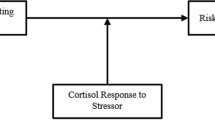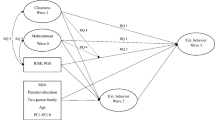Abstract
Children with older siblings are more likely to engage in risky behavior than their firstborn counterparts. Although the relationship between birth order and risky behavior may reflect the influence of older siblings, it is also possible that parents supervise later-born children less than firstborns. Using data from the National Longitudinal Study of Adolescent Health, we examine whether the association between birth order and risky adolescent behavior is driven by differences in the level of parental supervision. Firstborns are supervised more than their later-born siblings, but this difference does not explain the relationship between having an older sibling and risky behavior.
Similar content being viewed by others
References
Aizer A (2004) Home alone: supervision after school and child behavior. J Public Econ 88(9–10):1835–1848
Amato PR, Fowler F (2002) Parenting practices, child adjustment, and family diversity. J Marriage Fam 64(3):703–716
Amato PR, Rivera F (1999) Paternal involvement and children’s behavior problems. J Marriage Fam 61(2):375–384
Argys LM, Rees DI (2008) Searching for peer group effects: a test of the contagion hypothesis. Rev Econ Stat 90(3):442–458
Argys LM, Rees DI, Averett SL et al (2006) Birth order and risky adolescent behavior. Econ Inq 44(2):215–233
Behrman JR, Taubman P (1986) Birth order, schooling, and earnings. J Labor Econ 4(3):S121–S150
Bianchi S (2000) Maternal employment and time with children: dramatic change or surprising continuity? Demography 37(4):139–154
Bianchi S, Robinson J (1997) What did you do today? Children’s use of time, family composition, and the acquisition of social capital. J Marriage Fam 59(2):332–344
Black S, Devereux P, Salvanes K (2005) The more the merrier? The effect of family size and birth order on children’s education. Q J Econ 120(2):669–700
Blake J (1981) Family size and the quality of children. Demography 18(4):421–422
Blau F, Grossberg A (1992) Maternal labor supply and children’s cognitive development. Rev Econ Stat 74(3):474–481
Brook JS, Whiteman M, Brook DW et al (1991) Sibling influences on adolescent drug use: older brothers on younger brothers. J Am Acad Child Adolesc Psych 30(6):958–966
Brooks-Gunn J, Han WJ, Waldfogel J (2002) Maternal employment and children’s cognitive outcomes in the first three years of life: the NICHD study of early child care. Child Dev 73(4):1052–1072
Browning CR, Leventhal T, Brooks-Gunn J (2005) Sexual initiation in early adolescence: the nexus of parental and community control. Am Sociol Rev 70(5):758–778
Butcher KF, Case A (1994) The effect of sibling sex composition on women’s education and earnings. Q J Econ 109(3):531–563
Bryant WK, Zick C (1996) An examination of parent–child shared time. J Marriage Fam 58(1):227–237
Fletcher AC, Darling N, Steinberg L (1995) Parental monitoring and peer influences on adolescent substance use. In: McCord J (ed) Coercion and punishment in longterm perspectives. Cambridge University Press, Cambridge, pp 259–271
Hanushek EA (1992) The trade-off between child quantity and quality. J Polit Econ 100(1):84–117
Haurin RJ, Mott FL (1990) Adolescent sexual activity in the family context: the impact of older siblings. Demography 27(4):537–557
Hauser RM, Sewell WH (1983) Birth order and education attainments in full sibships. Working Paper No. 83-31. University of Wisconsin, Center for Demography and Ecology, Madison
Kessler D (1991) Birth order, family size, and achievement: family structure, and wage determination. J Labor Econ 9(4):413–426
Krcmar M, Greene K (2000) Connections between violent television exposure and adolescent risk taking. Media Psychol 2:195–217
Leibowitz A (1977) Parental inputs and children’s achievement. J Hum Resour 12(2):242–251
Mann J (1985) Latchkey kids try sex, study shows. The Washington Post, November 27, Wednesday, Final Edition, Health, p 9
Oettinger GS (2000) Sibling similarity in high school graduation outcomes: causal interdependency or unobserved heterogeneity? South Econ J 66(3):631–648
Olneck MR, Bills DB (1979) Family configuration and achievement: effects of birth order and family size in a sample of brothers. Soc Psychol Q 42(2):135–148
Ouyang L (2004) Sibling effects on teen risky behaviors. Mimeo, Duke University, Department of Economics
Price J (2008) Parent–child quality time: does birth order matter? J Hum Resour 43(1):240–265
Richardson J, Radziszewska B, Dent C et al (1993) Relationship between after-school care of adolescents and substance use, risk taking, depressed mood, and academic achievement. Pediatrics 92(1):146–148
Rodgers JL, Rowe DC, Harris DF (1992) Sibling differences in adolescent sexual behavior: inferring process models from family composition patterns. J Marriage Fam 54(1):142–152
Ruhm C (2000) Parental leave and child health. J Health Econ 19(6):931–960
Sayer L, Bianchi S, Robinson J (2004) Are parents investing less in children? trends in mothers’ and fathers’ time with children. Am J Sociol 110(1):1–43
Slomkowski C, Rende R, Novak S et al (2005) Sibling effects on smoking in adolescence: evidence for social influence from genetically informative design. Addiction 100(4):430–438
The National Center on Addiction and Substance Abuse (2003) Teen tipplers: America’s underage drinking epidemic. Columbia University. http://www.casacolumbia.org/pdshopprov/files/Teen_Tipplers_February_26_2003.pdf
Vandell DL, Ramanan J (1991) Children of the national longitudinal survey of youth: choices in after-school care and child development. Dev Psychol 27(4):637–643
Wang MQ, Fitzhugh EC, Westerfield RC et al (1995) Family and peer influences on smoking behavior among american adolescents: an age trend. J Adolesc Health 16(3):200–203
Widmer ED (1997) Influence of older siblings on initiation of sexual intercourse. J Marriage Fam 59(4):928–938
Zweigenhaft RL (2002) Birth order effects and rebelliousness: political activism and involvement with marijuana. Polit Psychol 23(2):219–233
Acknowledgements
The authors would like to thank several anonymous referees for insightful comments. They would also like to thank Asia Sikora and Dani Simova for excellent research assistance and to acknowledge support from the National Institute of Child Health and Human Development, contract number HD047661. The views expressed in this article are those of the authors and do not necessarily reflect the views of the National Institute of Child Health and Human Development. This research uses data from Add Health, a program project designed by J. Richard Udry, Peter S. Bearman, and Kathleen Mullan Harris, and funded by grant P01-HD31921 from the Eunice Kennedy Shriver National Institute of Child Health and Human Development, with cooperative funding from 17 other agencies. Special acknowledgment is due Ronald R. Rindfuss and Barbara Entwisle for assistance in the original design. Persons interested in obtaining data files from Add Health should contact Add Health, Carolina Population Center, 123 W. Franklin Street, Chapel Hill, NC 27516-2524 (addhealth@unc.edu). No direct support was received from grant P01-HD31921 for this analysis.
Author information
Authors and Affiliations
Corresponding author
Additional information
Responsible editor: Deborah Cobb-Clark
Rights and permissions
About this article
Cite this article
Averett, S.L., Argys, L.M. & Rees, D.I. Older siblings and adolescent risky behavior: does parenting play a role?. J Popul Econ 24, 957–978 (2011). https://doi.org/10.1007/s00148-009-0276-1
Received:
Accepted:
Published:
Issue Date:
DOI: https://doi.org/10.1007/s00148-009-0276-1




